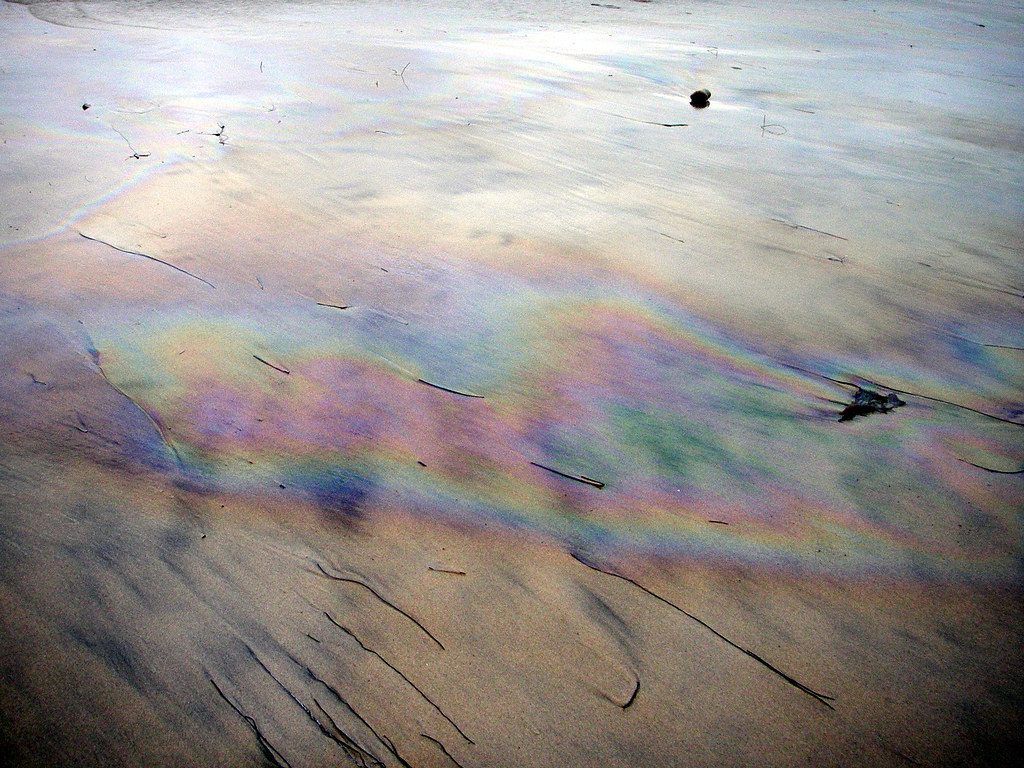
This photo is from today's SDUT website. I wish the photo was bigger but it is a good view of the Beacon's kelp beds. You can see the Coast Guard corralling the fuel in kelp bed on the left and if you look closely you can see the slick covering the kelp bed on the right.
The media and the powers that be are claiming this spill did not harm the kelp or the beach but I find that highly doubtful.

Burning question: Did the recently laid Grunion eggs survive the diesel fuel soaking? What effect will the fuel soaked sand have on shore birds that feed on invertebrates in the tide line?
Leucadia Blog: Beach Fuel Spill Part II
Leucadia Blog: Breaking News: Mysterious Fuel Spill at Beacon's Beach

Once you find out what the substance was you should be able to get your hands on the EPA doc's indicating the expected accute toxiciity of the substance. The EPA use to do extensive testing on things like fish to find out how much was too much.
ReplyDeleteWhich reminds me, did the haz mat team break out the goldfish for the goldfish test? They keep goldfish on the truck to test mysterious substances.
JP-
ReplyDeleteI will take a guess at your questions.
eggs are dead.
Birds will get sick and have long term impacts the same as if you and I ingested diesel.
Thanks for keeping connected while you're gone, Teresa. JP, your pictures, and coverage, are excellent.
ReplyDeleteAnd Dr. Lorri, thank you for the info. We think it was a Navy vessel, too, and that this could be determined by examining the fuel and the shipping records through public document requests. The City could pursue this, and ask for a fine against the "culprit."
Dripping cars need to be retired. Yes, and don't play in the poopy water flowing in through the storm drains.
Luckily diesel is very volitale, and floats on water far easier than crude oil or most petrolium products. The spill is probably not that large but is harmful none the less. It sucks that it hit our beaches amd that is no excuse. Was it the navy or a private boat transiting the area? more later....
ReplyDeleteRe all the hazardous materials ("hazmat") stuff...The fire department responds to all reports of toxic chemical spills. They respond to mitigate (or stop) the spill if possible. Emergency FD HM teams do NOT do clean up as they are available at scene or in quarters to respond to other hazmat emergencies should they arise.
ReplyDeleteFD HM teams do some hazardous materials analysis ("hazcatting" for hazardous materials categorizing). In the early years of hazmat response using goldfish was used by some agencies. Today even field analysis is much more sophisticated and the fish have been spared. The greater question is, has there been a fish kill and have any dead fished washed up on shore? This, unfortunately after the fact, would determine whether or not the spill was toxic to the fish life.
Clean up companies are usually privately owned and contract with government agencies. If there is a responsible party, that party can be charged with numerous violations of the law and be required to pay for the clean up. If there is no responsible party the taxpayers will pay for the clean up via government resources.
The Coast Guard can and will do some clean up. Life guards neither respond to hazmat events as mitigators or as clean up personnel.
Further investigation should determine whether or not the emergency response and/or the clean up was mishandled.